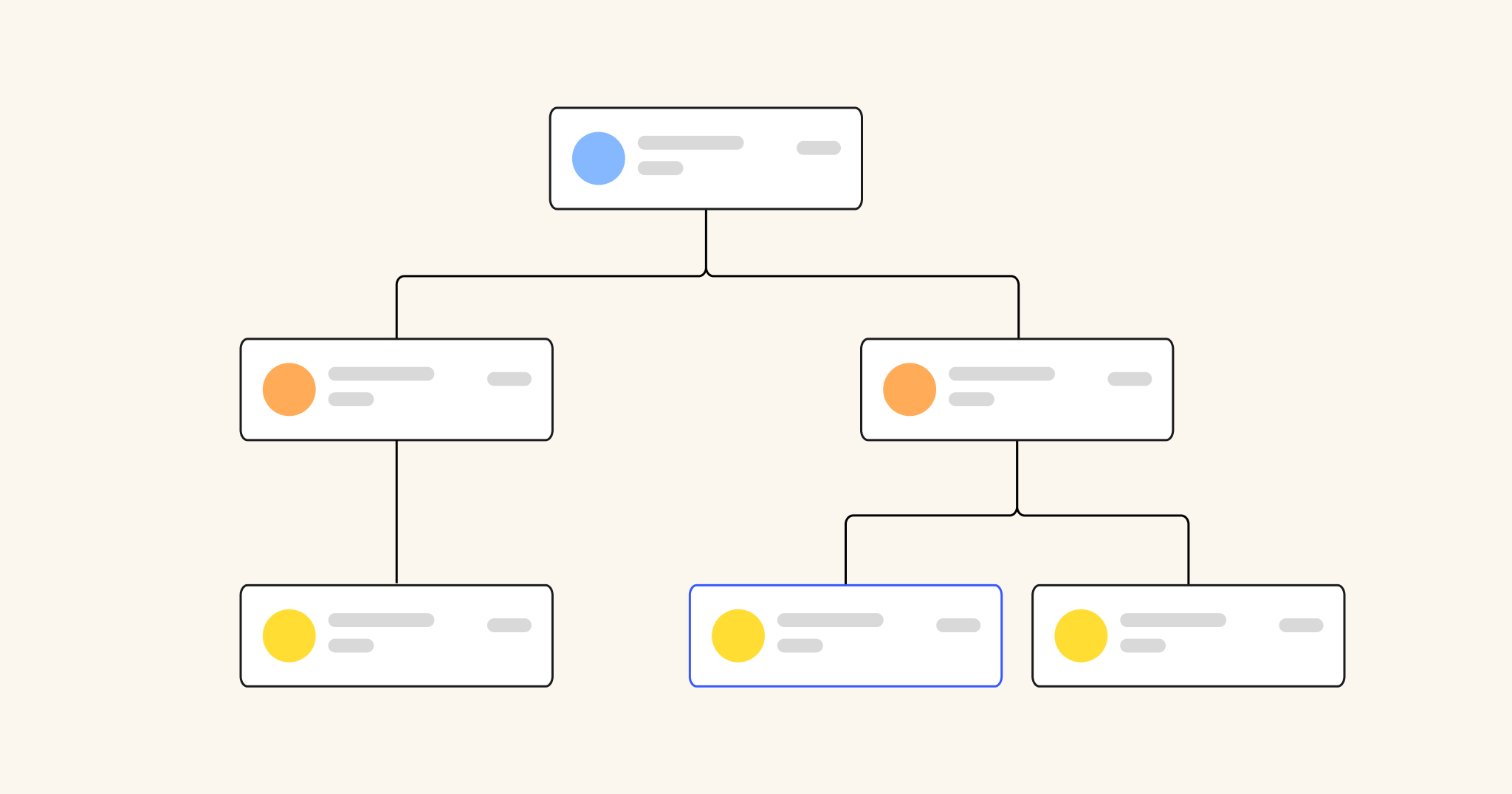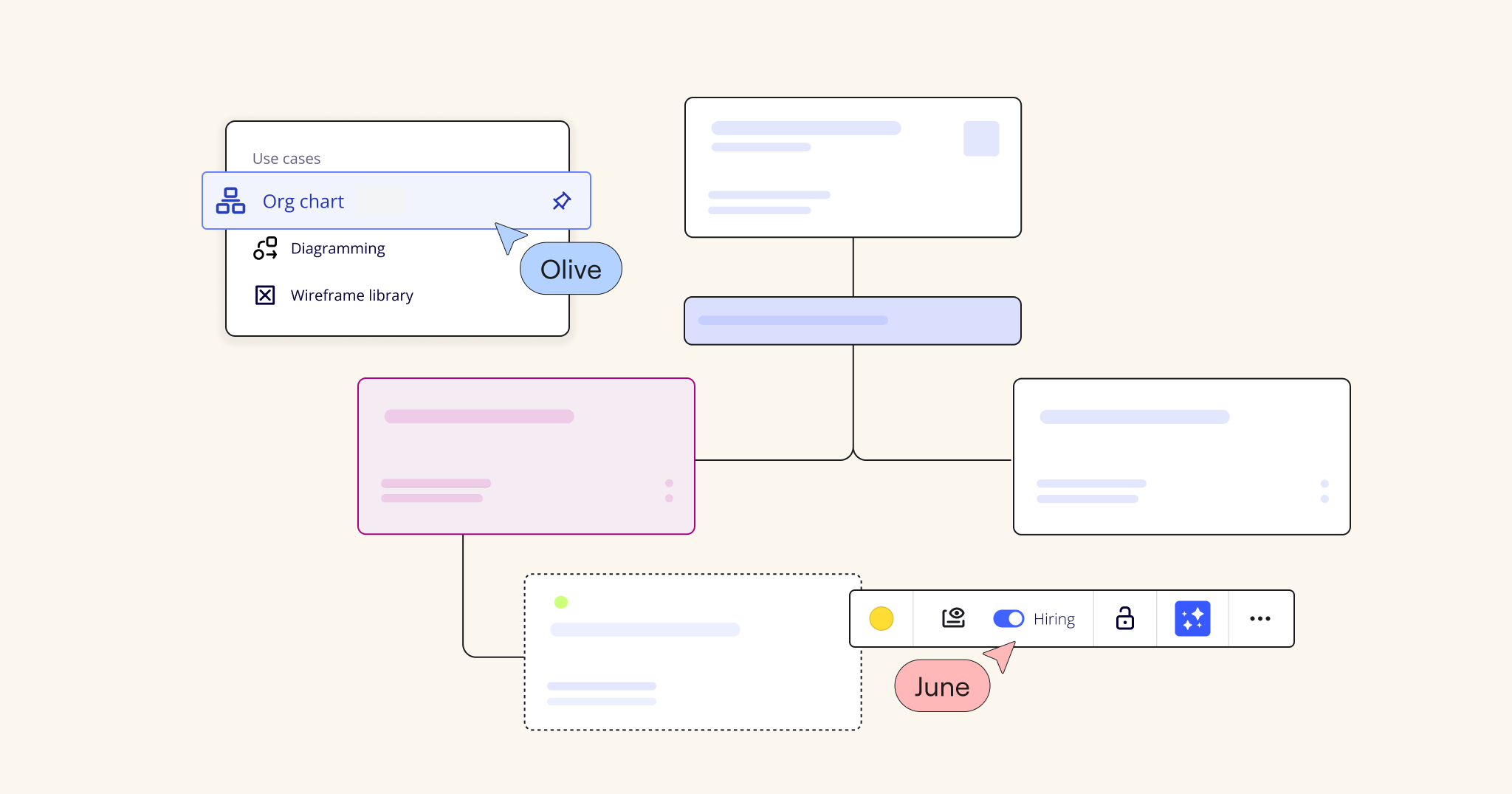Can your org chart fit on an 8.5-by-11-inch piece of paper? Chances are, it can’t. Yet, many companies still try to create their org charts in Word or Powerpoint. If your organization is more dynamic than static, it’s time to level up.
An org chart is a map of relationships. At a basic level, it illustrates who is responsible for what and whom. There are many types of org charts to choose from, depending on your company size, structure, and preferences. Keep reading to discover four types of highly adaptable and scalable org charts — with bonus templates to help you get started.
Why org charts are still the industry standard
While the concept behind org charts is simple, they pack in a lot of information and complexity. Here’s why they’re still so effective.
- They’re visual. You can follow reporting lines and see responsibility areas at a glance.
- They’re adaptable. As employees come and go, or as your org structure changes, it’s easy to update your chart with small tweaks.
- They’re scalable. Growing fast? There’s no need to start your org chart over from scratch. You can simply add new branches (especially with an infinite canvas).
Not all org charts are structured the same. As you begin to work on yours, consider which design will best fit your needs. Let’s take a look at the four primary types of org charts.
4 types of org charts to fit any organizational structure
1. Hierarchical org chart
This is likely the model that comes to mind when someone mentions a traditional org chart. Also called the vertical or top-down org chart, a hierarchical org chart uses connected boxes to show reporting lines from top to bottom. Larger boxes represent leadership positions, then there are smaller boxes for middle management, frontline, or entry-level workers.
When to use hierarchical org charts
This traditional approach is a good choice for many companies because it’s recognizable, logical, and easy to interpret. It’s ideal for visualizing a divisional organizational structure, where a company organizes departments as self-contained business units. For example, each service line would have its own marketing and sales teams within the unit.
Hierarchical org chart example
With Miro’s vertical organizational chart, you can outline a hierarchical structure starting with the C-suite at the top. Department heads each start their own branch, with their direct reports linked below. In this template, management levels are color-coded and you can personalize the org chart with photos and names.
2. Inverted org chart
The inverted org chart is very similar to its top-down twin. But instead of branching hierarchically from top to bottom, it runs from bottom to top.
When to use inverted org charts
By flipping the traditional org chart on its head, the inverted org gives a more employee-centric view of an organization. This is useful for onboarding and training new employees, and helping them understand how upline communication works within your company.
Inverted org chart example
This inverted org chart from Miro uses a simple structure to illustrate the chain of command, starting from frontline employees. You can adapt this template to virtually any industry or company.
3. Circular org chart
The first known org chart dates back to 1855: a circular org chart showing the Erie Railroad’s organizational structure. The chart resembles a sort of flower, with divisions stemming out from the president and board of directors in the center. While modernized, today’s circular org chart follows a similar flow.
When to use circular org charts
While you can represent a divisional or functional organizational structure in a circular org chart, the best use is illustrating a flat or horizontal structure. A flat organizational structure has few levels of management and emphasizes connected teams without a rigid chain of command. The circular org chart’s round structure visually flattens the hierarchy and lets you show lateral relationships between divisions.
Circular org chart example
In this circular org chart template, place the company logo or your president or CEO in the middle. From there, leaders branch off, then teams branch off from them. You can use dotted lines as connectors between teams and individuals to show indirect reporting lines.
4. Matrix org chart
Often, a hierarchical structure doesn’t capture the realities of cross-departmental collaboration. Many companies operate as a matrix organization, where employees receive assignments from multiple people and work on projects under a project manager who isn’t their boss. For them to truly understand their roles and how to navigate multiple reporting lines, you need a matrix org chart.
When to use matrix org charts
Matrix org charts are useful for showing functional organizational structures and project org structures. For example, say that you have a centralized creative team that reports to the CMO but serves the entire organization, from individual business units to HR. A matrix org chart can visualize this complexity.
Matrix org chart example
In this example, there are columns for each team with boxes showing each person’s role. There’s also a separate column for Director of Projects, which lists the core projects under their jurisdiction. Then, arrows connect each project with the participating team members.
Best Miro features for org charting
Now that you’ve seen how rich and diverse org charts can be, it’s time to spring into action and start creating. You already have access to four editable org chart templates. Simply copy one, create an account, and start customizing.
Unlike in spreadsheets or word processors where you can’t customize much, Miro has an organizational chart maker with a user-friendly, drag-and-click design. Here are five features that make it easy to make a custom org chart.
- Mind map. A mind map is a free-form branching structure that connects concepts — or in the case of an org chart — people. Simply click to create connectors between boxes or sticky notes.
- Shapes and lines. Choose from a library of basic and complex shapes, change the color, and add text. Then, connect shapes with lines. You can use different line styles to signify different things, like solid and dotted lines for direct and indirect reporting.
- Cards. A Miro card is a textbox on your board that represents a task. You can use this to assign projects to users, much like a Jira card (in fact, these integrate with Jira cards). If you keep an org chart in the cloud, you can add cards to request users like HR or managers to update organizational changes as they occur.
- Auto-layout. Trying to manually align lines and boxes is no one’s idea of a good time. Save yourself the hassle with auto-layout, which snaps elements to a grid and automatically aligns space between them.
- Images, icons, and videos. While many label org chart boxes simply with job titles, you can personalize them further with photos or avatars to help new employees get acquainted with the team. You can also use Talktrack to let employees leave a quick video introduction of themselves. Get creative! Just keep in mind that this takes more time and effort to maintain.
Whether you use a divisional, matrix, flat, or functional structure, you can communicate your organizational structure in a way that serves everyone no matter where they fall on the chart.



